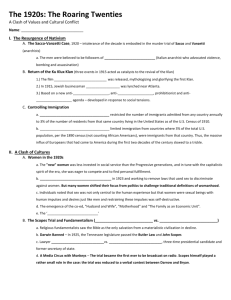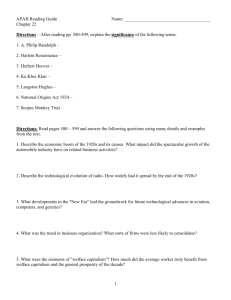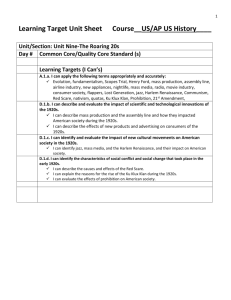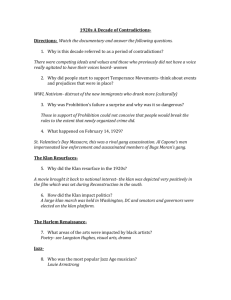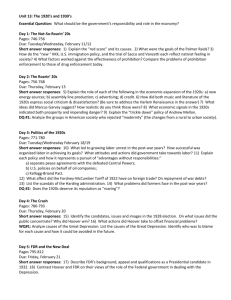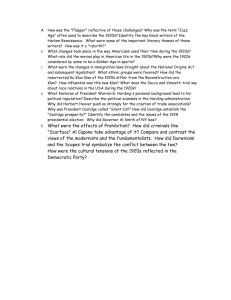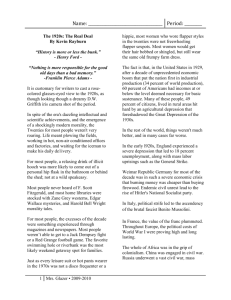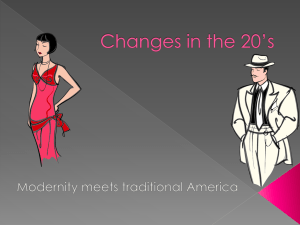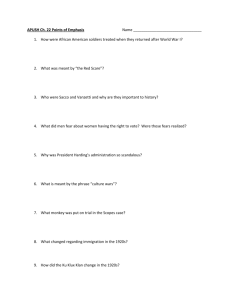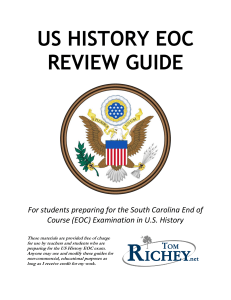Intensive Review - Standard 6
advertisement
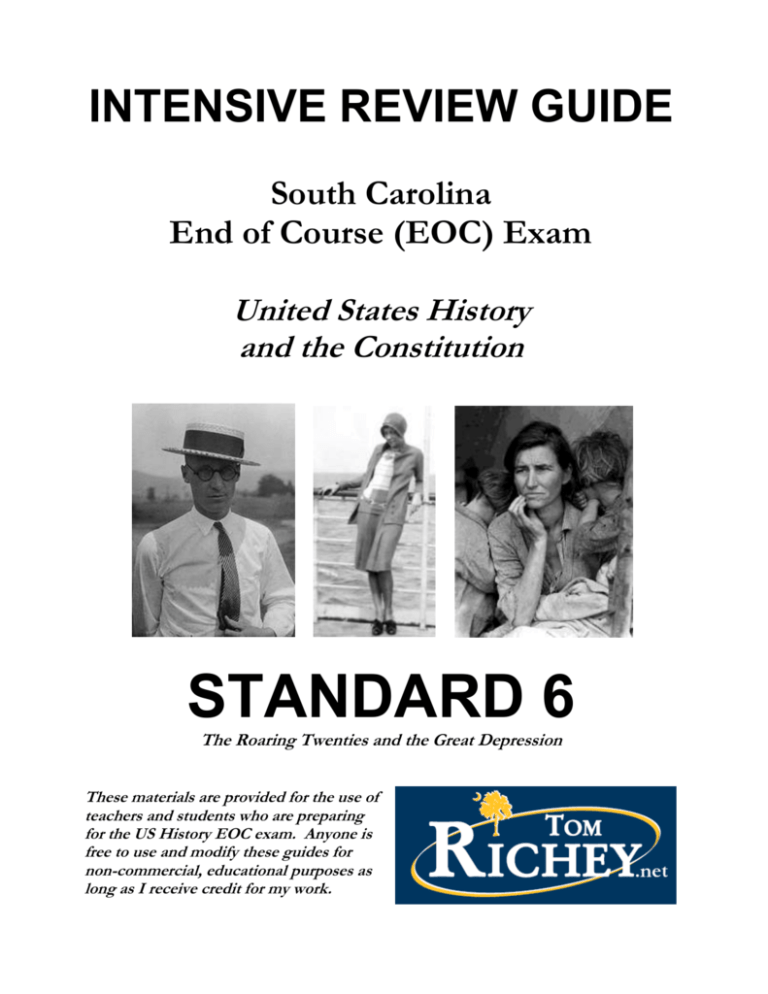
INTENSIVE REVIEW GUIDE South Carolina End of Course (EOC) Exam United States History and the Constitution STANDARD 6 The Roaring Twenties and the Great Depression These materials are provided for the use of teachers and students who are preparing for the US History EOC exam. Anyone is free to use and modify these guides for non-commercial, educational purposes as long as I receive credit for my work. USHC 6.1 Explain the impact of the changes in the 1920s on the economy, society, and culture, including the expansion of mass production techniques, the invention of new home appliances, the introduction of the installment plan, the role of transportation in changing urban life, the effect of radio and movies in creating a national mass culture, and the cultural changes exemplified by the Harlem Renaissance. A BOOMING ECONOMY! The Losers: The U.S. experienced unprecedented economic growth during the 1920s, but not everyone shared in the prosperity. There was a widening GAP between the “haves” and the “have nots.” 1. __________________ (low crop prices) 2. __________________ (anti-union sentiment) Mass Production Henry Ford’s _________________ Line made production more efficient but cut out the need for skilled laborers. Automobiles became prevalent during the 1920s because of Ford’s assembly line. Many other products, such as _____________ and ______________, were mass produced on assembly lines. Household Appliances and Consumer Culture New electric appliances, such as the vacuum cleaner, iron, and washing machine made it easier than ever for housewives to do household chores. ADVERTISING!!! Americans who couldn’t afford the new appliances purchased them on the _________________ plan. _____________ NOW Pay _____________! RESULT: _________________ African Americans in the 1920s The Great Migration _________ Music Stereotyping in Film Birth of a Nation Black Americans leave the South to Search for _____________ Escape ________________ Black musicians played for white audiences, leading to some cultural exchange. (Popular film promoted racial stereotypes and made the KKK appear heroic.) 2 ________ Renaissance An African American artistic and literary movement. _____________ Hughes (Famous Writer) USHC 6.2 Explain the causes and effects of the social change and conflict between traditional and modern culture that took place during the 1920s, including the role of women, the “Red Scare”, the resurgence of the Ku Klux Klan, immigration quotas, Prohibition, and the Scopes trial. Nativism ___________________ - Fear of Foreigners American nativism reached a new peak in the 1920s due to the effects of WWI propaganda and the __________________ Revolution in 1917. This political cartoon showcases American fears that many of the “New Immigrants” from Southern and Eastern Europe were __________________, __________________ , or __________________ . [First] Red Scare FEAR of a _______________ takeover of the United States _______________ Raids (4000 alleged communists arrested – hundreds deported) Immigration Quota Acts Sacco and Vanzetti Trial Placed quotas on immigration from _____________ and _____________ Europe Two ___________ immigrants were found guilty of murder and executed based on questionable evidence of guilt (New Immigrants) The Role of Women Although women could vote in the 1920s thanks to the passage of the ___th Amendment, women made little impact on politics, typically voting the same way as their husbands did. Many young women, known as _______________, challenged cultural norms of “ladylike” behavior. Flappers could be identified by their short hair, knee-length skirts, and their permissive lifestyles. Flapper culture had very little impact on women, as a whole, as most women either stayed at home and made use of their new electrical appliance or worked menial jobs where they were paid less than men. A “Flapper” Prohibition ORIGINS: _______________ Movement (Antebellum Period) Prohibition gained traction during WWI due to anti-German sentiment and the wartime push to conserve grain (the primary ingredient in beer and liquor). __th Amendment ENFORCEMENT UNSUCCESSFUL Banned the sale and consumption of “intoxicating liquors” _____________________ _____________________ Illegal alcohol sellers Private clubs where alcohol was illegally consumed (e.g., Al Capone) 3 __st Amendment REPEALED the 18th Amendment (1933) The Scopes “___________” Trial QUESTION: How do we explain the origins of humanity? FACT: The phrase, “Monkey Trial,” was coined by H.L. Mencken, a reporter covering the trial for the Baltimore Sun. Religious _________________ Modern Science “Conservative” “Liberal” The ____________ contains a literal and true account of creation by God. VS. Charles ______________ Theory of __________________ In 1925, the Tennessee legislature passed a law forbidding the teaching of Charles Darwin’s theory of ________________ in public schools. John Scopes, a substitute teacher and football coach, taught a lesson on evolution so that the town of Dayton, Tenn., could host a trial. The trial received national media coverage. William Jennings Bryan, a Fundamentalist, Scopes was defended by an attorney from the volunteered to prosecute the case against A________________ C________________ Scopes. L________________ U________________. The [Second] Ku Klux Klan Nativist sentiment and the success of the film, Birth of a Nation, laid the groundwork for a revival of the Ku Klux Klan. Members of the “Second” Ku Klux Klan cast themselves as the guardians of “One Hundred Percent __________________” “TRUE AMERICAN” “UNAMERICAN” 1. _________________ 1. _________________ 2. _______________ Born 2. _______________ Born 3. _________________ 3. ____________ or Jewish The Klan considered anyone “Un-American” who did not fit the “WASP” [White Anglo-Saxon Protestant] profile. Note that while the Klan was a white supremacist organization, it also targeted immigrants and religious minorities. Klan members march on Washington in the 1920s. MORAL WATCHDOG: The Klan also supported Prohibition, opposed bootlegging and gambling, and held its members of high moral standards. This function of the Klan was undermined by scandals involving its members in the late 1920s and early 1930s. NATIONWIDE: The Klan’s membership exceeded four million in the 1920s, and the organization was stronger in the _________________ (Indiana, Ohio, etc.) than it was in the South. 4 USHC 6.3 Explain the causes and consequences of the Great Depression, including the disparities in income and wealth distribution; the collapse of the farm economy and the effects of the Dust Bowl; limited governmental regulation; taxes, investment; and stock market speculation; policies of the federal government and the Federal Reserve System; and the effects of the Depression on the people. Causes of the Great Depression DEBT Consumers bought goods on credit during the 1920s, and most Americans were heavily indebted by the end of the decade. Factors Contributing to Consumer Debt: The __________ _________’s “Easy Money” Policies Overconsumption During the 1920s, the Federal Reserve kept interest rates low, which encouraged borrowing. Consumers borrowed money to pay for new appliances and other consumer goods, purchasing these items on the After the stock market crash, the Fed suddenly TIGHTENED the money supply. Stock Market SPECULATION SPECULATION: Buying on the ______________ _____________ plan. (Borrowing $$$ to buy stocks) By the late 1920s, consumers had so much debt that they could no longer pay for expensive consumer goods, which lowered demand. This resulted in overproduction, resulting in decreased profits for companies. STOCK MARKET ________________________ (1929) Dust Bowl Farm Economy COLLAPSES “_______________” migrate to California looking (unsuccessfully) for work. d UNEMPLOYMENT: ___% President Herbert __________________ tried unsuccessfully to help: 1. Tax ____________________ 2. ___________-____________ Tariff (Second Highest in US History) INEFFECTIVE Hoover REJECTED the idea of ________________ RELIEF to the poor. (payments from the government to individuals) In 1932, a group of World War I veterans known as the “______________ Army” marched on Washington to demand an early payment of their “Bonus,” or veterans pensions that were due to be paid in 1945. “_________________” became a symbol of most Americans’ lack of confidence in Hoover’s leadership. The U.S. Army attacked the Bonus Army with cavalry, tanks, and gas, furthering the impression that Hoover was callous toward those who were suffering during the Depression. 5 USHC 6.4 Analyze President Franklin Roosevelt’s New Deal as a response to the economic crisis of the Great Depression, including the effectiveness of New Deal programs in relieving suffering and achieving economic recovery, in protecting the rights of women and minorities, and in making significant reforms to protect the economy such as Social Security and labor laws. The New Deal Franklin D. The “Three R’s” of the New Deal: __________ (FDR) (Elected 1932) First Lady: _____________ PANIC: R_________________ R_________________ R_________________ Successful? ___________________ ___________________ ___________________ “The only thing we have to fear is _____________, itself.” – Inaugural Address FDR addressed panic by declaring a bank ______________ and used “_____________ chats,” radio addresses that he used to explain his plans to the people in plain language. FDR’s Alphabet Soup (New Deal Agencies created by the FDR administration) Name: ____________________________________________ (FDIC) Purpose: AAA Name: Agricultural Adjustment Administration (AAA) Purpose: Name: National Recovery Administration (NRA) Purpose: SEC Name: ____________________________________________ (SEC) Purpose: Name: ____________________________________________ (TVA) Purpose: CCC Name: Civilian Conservation Corps (CCC) Purpose: SSA Social Security Administration NLRB 6 National Labor Relations Board Criticisms of the New Deal From the “Left” From the “Right” The Supreme Court and the New Deal In Schechter v. United States (1935), the Supreme Court declared the National Recovery Act __________________________. This is an example of judicial _________________, a principle established by John Marshall in ________________ v. _________________. In response to the Supreme Court’s ruling, FDR presented a plan to Congress to __________________ the Supreme Court, which would have allowed the president to appoint more justices to the Court. This plan undermined the system of _________________ and ________________ that are enshrined in the U.S. Constitution. Congress rejected the “court packing” plan, handing FDR his first major legislative defeat. African Americans and the New Deal African American workers were typically the __________________ hired and the ________________ fired, leading to black workers suffering from a much higher level of unemployment (50%) than whites (25%). Although FDR took little official action to combat racial discrimination, black voters began to align themselves with Roosevelt’s _________________ Party in the 1930s. Before the New Deal, African American voters had typically supported the ________________ Party. The New Deal ( did / did not ) bring about economic recovery in the 1930s. However, New Deal programs ( did / did not ) provide relief for people who were suffering during the Depression. 7
